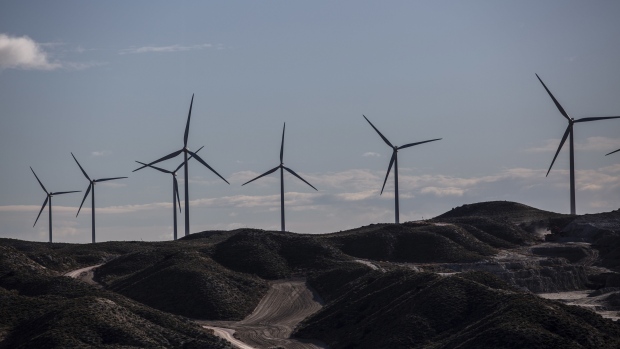Jan 21, 2022
EU Fractures Dream of Gold Standard for Green Market Investors
, Bloomberg News

(Bloomberg) -- The European Union is ripping up the green investing playbook with plans to allow some gas and nuclear projects to be called sustainable.
The bloc is poised to include these kinds of power generation with conditions in its rulebook for sustainable activities, or taxonomy. That’s divided the fund community, as some worry their holdings will no longer be in line with the rules, while others think it’s a necessary compromise to transition to a cleaner economy.
Such distinctions have become increasingly important for the trillions invested in environmental, social and governance assets, since Europe’s anti-greenwashing rules require investors to report the proportion of funds aligned with its taxonomy. It also throws a question mark into what can be funded with the burgeoning market for green bonds and loans, adding confusion when the new rules were meant to bring clarity.
“How are we going to explain to our clients that our products, which might score lower on taxonomy-alignment, are more sustainable than other products?” said Hans Stegeman, chief investment strategist at Triodos Investment Management. “That’s the core of our problem.”
The bloc’s rules for what counts as green enough in investments and bonds were heralded last year as a “gold standard” and counterbalance to mounting fears of the finance industry overstating environmental benefits. It’s now expected to accede to pressure by some member states to include gas and nuclear, after a consultation ending Friday.
Much of the tension boils down to the taxonomy’s dual purpose: avoiding misrepresentation by investors but also determining future EU funding decisions. Giving a temporary green label to gas projects could facilitate cleaning up coal in countries like Poland, while the inclusion of nuclear would direct private finance to France or the Czech Republic.
For the Institutional Investors Group on Climate Change, which includes the asset management arms of JPMorgan Chase & Co. and Goldman Sachs Group Inc., that will undermine efforts to reach climate neutrality by 2050 and the EU’s ambitions to set the international benchmark for standards. It’s “strongly opposed” to the inclusion of gas.
EU Faces Investor Backlash as Gas Headed for Green Rulebook
Amundi Asset Management and Robeco are among investors that are more sanguine, pointing to the strict conditions that eligible projects will be subject to. These include limiting gas plants to those that replace coal, emitting no more than 270 grams of carbon dioxide equivalent per kilowatt-hour, and switching to renewable or low-carbon gases by 2036.
To prevent the inclusion of gas and nuclear would require at least 20 member states -- representing at least 65% of the EU’s population -- to collectively reject the rule in coming months, which seems unlikely. France’s power supply is dominated by nuclear, while countries from Germany to Poland still generate much of their electricity from coal.
“If you want to forge an acceptable transition, there was probably a need to find compromises to make it happen,” said Jean-Jacques Barberis, director of the institutional and corporate clients division and ESG at Amundi, and a former official in France’s finance ministry. “It’s not possible to continue to live in a world where the standards are not comparable.”
Two-tier Market
Yet the EU’s current proposals may not even be legal, as they aren’t consistent with the target of limiting a global rise in temperatures, according to the two lawmakers responsible for guiding the legislation through the European Parliament. A body created to help the EU reach net-zero carbon emissions by mid-century intends to slam the move.
Other investors warn that the EU’s plans could have knock-on repercussions for future pieces of climate legislation such as the EU Green Bond Standard. That aims to raise the bar for checks and balances in the $3 trillion sustainable debt market, where any issuance so far by fossil-fuel firms or nuclear generators has been controversial.
The move to include them in the taxonomy could end up creating a two-tier system of sustainable assets as investors superimpose their own environmental scruples onto the EU’s definitions.
“The EU GBS could still use the taxonomy as a basis, but add additional rules (i.e. no gas/nuclear), thus essentially creating a taxonomy+ tier of green assets,” said Stephan Kippe, head of ESG research at Commerzbank AG. “That would of course weaken the status of the taxonomy as a “gold standard” and do little to increase transparency.”
EU Lawmakers Push for Stricter Bond Rules to Avoid Greenwashing
Non-profit organization Climate Bonds Initiative, which provides green bond data to index providers, said it is “almost impossible” to get natural gas projects’ emissions low enough to help mitigate climate change. That’s in part due to difficulties in monitoring emissions such as methane leakages, according to Krista Tukiainen, head of market intelligence at CBI, which has excluded gas from its own taxonomy.
Awfully Complicated
Yet for Robeco, the EU’s red lines for natural gas render the proposals broadly in line with their pre-existing sustainable investment principles. It currently excludes nuclear from some ESG-focused investing strategies.
This divergence in how asset managers and bond funds are approaching gas and nuclear has prompted calls for investors to report such investments separately from other taxonomy-aligned assets, even if they are technically eligible.
The risk of portfolio managers applying their own standards means a descent into something “awfully complicated” for both investors and the industry, said Amundi’s Barberis. Others see it as essential.
“Asset managers need to explain clearly what they are doing -- with and without gas and nuclear,” said Philippe Zaouati, CEO of sustainability-focused Mirova.
©2022 Bloomberg L.P.


